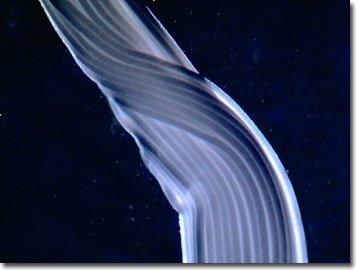Darkfield Digital Image Gallery
Lycra Spandex
As the premiere synthetic stretch fabric, lycra spandex is the trade name for DuPont's version of the long-chain polymeric fiber. Invented at DuPont by American scientist Joseph C. Shivers in 1959, spandex sprang on the market as a replacement for rubber (latex) in women's foundation garments.

Polyether polyols, soft and rubbery segments of the polyester chain allow spandex to stretch up to 600 times its resting length and then recover its original shape. Urethanes or urethane-ureas constitute hard segments in the synthetic compound that provide rigidity, impart tensile strength, and limit plastic flow. 1,4-butanediol (4 carbons, 10 hydrogens, and 2 oxygens per molecule), a precursor for spandex and the polyurethane used to manufacture car bumpers, has more recently made it on to the drug enforcement watch list as the main constituent for the "date rape" recreational drug, gamma hydroxybutyrate (GHB). Phosgene, (1 carbon, 2 chlorine, and 1 oxygen atoms per molecule), known also as mustard gas, is used to make the diisocyanate monomers used in spandex fabrication, but under heightened alert is watched worldwide in illicit bioweapons arsenals. Also key in the production of spandex is the intermediary 4,4'-methylenedianiline (MDA) (13 carbons, 14 hydrogens, 2 nitrogens), which is classified by the U.S. Environmental Protection Agency as a hazardous chemical, capable of causing severe liver damage to exposed humans and animals. At DuPont, macromolecular engineers modify the structure of the polymer by using chemical additives, or change the properties of the spandex polymer, such as how it responds to light and heat, meeting new demands and continuing to expand lycra's use in the marketplace.
Known as elastane in Europe, spandex is always blended with other natural and synthetic fibers such as cotton, wool, silk, and linen. Replacing rubber thread, lycra is lighter and does not decompose when exposed to perspiration, body oils, skin lotions, perfumes, or detergents. Although ladies' undergarments including a 1960s boom in soft-support pantyhose still underlie the spandex market, the remarkable synthetic fiber soon found its way into figure-flattering swimwear and by 1968, hit the slopes with the French Olympic ski team. By the 1970s, bicycle racers traded in their old woolen shorts for snazzy and aerodynamic spandex shorts. Next, there were dancewear, tights, stretch jeans and the venerable icon of the 1980s, the jogging suit, some of which reached the gyms and athletic fields and many that never left the dance floor and the fashion scene. The future for spandex is uncorseted and it is expected to squeeze its way into the upholstery of stylish furniture and automobiles, as well-fitting bed linens, and blended with leather and synthetics for truly comfortable shoes that put a spring in your step.
Once only the domain of DuPont, that company still manufactures the lion's share of spandex but in the United States, glospan, cleerspan, and dorlasten compete against lycra spandex. Bayer also manufactures spandex in Germany, and in Japan, Asahi Chemical Industry and Toyobo are world leaders in spandex production as is South Korea's Tae Kwang Industrial Company. So valuable are trade secrets in DuPont's lycra spandex technology, that in 1989, five DuPont employees from the spandex plant in Mercedes, Argentina tried to extort $10 million dollars for the safe return of some stolen proprietary production documents. After a globetrotting chase that bounded from Wilmington, Delaware to Milan, Italy and Geneva, Switzerland, Swiss police and the FBI staged a sting for the documents that went awry. Eventually the extortionists were nabbed by the long arm of the law in a Geneva parking lot and bounced into prison.
Contributing Authors
Cynthia D. Kelly, Thomas J. Fellers and Michael W. Davidson - National High Magnetic Field Laboratory, 1800 East Paul Dirac Dr., The Florida State University, Tallahassee, Florida, 32310.
BACK TO THE DARKFIELD IMAGE GALLERY
BACK TO THE DIGITAL IMAGE GALLERIES
Questions or comments? Send us an email.
© 1995-2025 by Michael W. Davidson and The Florida State University. All Rights Reserved. No images, graphics, software, scripts, or applets may be reproduced or used in any manner without permission from the copyright holders. Use of this website means you agree to all of the Legal Terms and Conditions set forth by the owners.
This website is maintained by our
Graphics & Web Programming Team
in collaboration with Optical Microscopy at the
National High Magnetic Field Laboratory.
Last Modification Friday, Nov 13, 2015 at 01:19 PM
Access Count Since September 17, 2002: 35732
Visit the website of our partner in introductory microscopy education:
|
|
